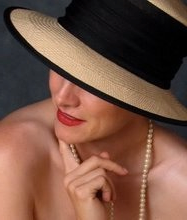 Hollywood does a better job of preparing the stars for their big moment, but sometimes not by much. When something is out of proportion, the human eye picks up on it in a split-second and tells us so. Thousands of years ago, the Greeks set out to explain beauty as a mathematical relationship: the 'Golden Ratio' expressed as 1 to 1.618. This is not to say that you can't make it in Hollywood without your teeth. Just ask Walter Brennan!
Hollywood does a better job of preparing the stars for their big moment, but sometimes not by much. When something is out of proportion, the human eye picks up on it in a split-second and tells us so. Thousands of years ago, the Greeks set out to explain beauty as a mathematical relationship: the 'Golden Ratio' expressed as 1 to 1.618. This is not to say that you can't make it in Hollywood without your teeth. Just ask Walter Brennan!Who has the most ridiculous fake teeth these days? Oh, the choices.
 Gary Busey probably has the scariest: "[m]y teeth have been identified as a piano farm." Showing too many new and improved teeth can also be disconcerting in a big-bad-wolf way: the leering smiles of Dyan Canon and Sally Kellerman in Boynton Beach Bereavement Club (2005) or latter-day Loretta Swit all come to mind.
Gary Busey probably has the scariest: "[m]y teeth have been identified as a piano farm." Showing too many new and improved teeth can also be disconcerting in a big-bad-wolf way: the leering smiles of Dyan Canon and Sally Kellerman in Boynton Beach Bereavement Club (2005) or latter-day Loretta Swit all come to mind.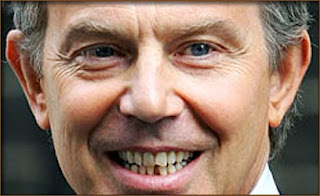 Of course, the British are famous for bad teeth. Tony Blair perhaps exemplifies that nation's trend to go with what you've got. And it certainly works in character parts and comedy. As Mike Myers knows, yeah baby! he can get a laugh just by opening Austin Power's lips.
Of course, the British are famous for bad teeth. Tony Blair perhaps exemplifies that nation's trend to go with what you've got. And it certainly works in character parts and comedy. As Mike Myers knows, yeah baby! he can get a laugh just by opening Austin Power's lips.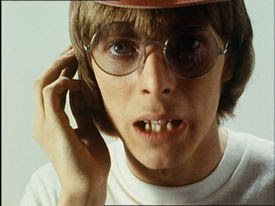
 But there are plenty of celebrity Brits who went in for extreme mouth makeovers with their first paycheck. David Bowie wasted no time. A long-time heavy smoker, his porcelain crowns and veneers are impervious to staining. Victoria Beckham, the poster child for healthy body image, reputedly forgoes smiling because she dislikes her teeth so much– despite having had work done.
But there are plenty of celebrity Brits who went in for extreme mouth makeovers with their first paycheck. David Bowie wasted no time. A long-time heavy smoker, his porcelain crowns and veneers are impervious to staining. Victoria Beckham, the poster child for healthy body image, reputedly forgoes smiling because she dislikes her teeth so much– despite having had work done. It goes without saying that no one in Hollywood can brush their teeth without wearing sunglasses to prevent being Blinded by the White. America Ferrera had her smile insured for $10 Million through Lloyd's of London. Aquafresh White Trays is sponsoring the insurance and donating $1 for every box sold between now and August 31 to a program which provides dental care for women in need. Dental bleaching can also be done professionally in the dentist's chair using light- or laser-assisted procedures using higher-concentration peroxide gel or take-home teeth molds and application instructions.
It goes without saying that no one in Hollywood can brush their teeth without wearing sunglasses to prevent being Blinded by the White. America Ferrera had her smile insured for $10 Million through Lloyd's of London. Aquafresh White Trays is sponsoring the insurance and donating $1 for every box sold between now and August 31 to a program which provides dental care for women in need. Dental bleaching can also be done professionally in the dentist's chair using light- or laser-assisted procedures using higher-concentration peroxide gel or take-home teeth molds and application instructions.Getting porcelain veneers is a more intensive procedure. A veneer is a thin shell of porcelain with a color, translucence, and texture that is similar to tooth enamel. It is bonded permanently to the tooth, usually the front ones, by resin cement after acid etching or filing of the damaged, discolored, or misshaped tooth. They're the up-to-date version of the crown, which goes over the whole tooth and preserves less of the original tooth.
 One mistake people make is mismatching their tooth color with their skin tones, hair and age. "When somebody's teeth jump out and seem like a night light in a dark room, that's porcelain veneers or crowns," said one high-profile Beverly Hill's cosmetic dentist. "The Regis Philbin Chicklet look, that opaque white that looks ridiculous, you're not going to get that with bleaching."
One mistake people make is mismatching their tooth color with their skin tones, hair and age. "When somebody's teeth jump out and seem like a night light in a dark room, that's porcelain veneers or crowns," said one high-profile Beverly Hill's cosmetic dentist. "The Regis Philbin Chicklet look, that opaque white that looks ridiculous, you're not going to get that with bleaching."

 Generally, veneers are used when a star's grin has spaces or crooked, chipped or small teeth. For example, Hilary Duff recently got porcelain veneers to go over at least six of her front teeth.
Generally, veneers are used when a star's grin has spaces or crooked, chipped or small teeth. For example, Hilary Duff recently got porcelain veneers to go over at least six of her front teeth. 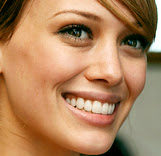 As Duff explained, "[m]y teeth aren't the strongest, and I kept chipping them on the microphone."
As Duff explained, "[m]y teeth aren't the strongest, and I kept chipping them on the microphone."
 The changed proportions of Hilary Duff's smile have been widely commented on. The veneers break that 'Golden Ratio' and the viewer's mind rejects the look as horsey. Another example is Jessica Simpson's fake front teeth: her ever-so-slight overbite brings on images of a rabbit once you've placed overly bright veneers over them.
The changed proportions of Hilary Duff's smile have been widely commented on. The veneers break that 'Golden Ratio' and the viewer's mind rejects the look as horsey. Another example is Jessica Simpson's fake front teeth: her ever-so-slight overbite brings on images of a rabbit once you've placed overly bright veneers over them. Although not known for his on-camera grinning, Michael Douglas been smiling a lot after marrying again. He also has had a less-than-subtle procedure that harks back to the days of dentures look. (Catherine Zeta Jones had her own pearly whites done while performing in The Darling Buds Of May series in the early '90s.) Teeth tend to wear down due to osteoporosis of the upper/lower jaw as well as discolor with age. There is a loss in facial fat in the mouth region, a deflation of the lips as well. Look at any photograph from the turn of the century to see what tooth loss does for the over-40 mouth.
Although not known for his on-camera grinning, Michael Douglas been smiling a lot after marrying again. He also has had a less-than-subtle procedure that harks back to the days of dentures look. (Catherine Zeta Jones had her own pearly whites done while performing in The Darling Buds Of May series in the early '90s.) Teeth tend to wear down due to osteoporosis of the upper/lower jaw as well as discolor with age. There is a loss in facial fat in the mouth region, a deflation of the lips as well. Look at any photograph from the turn of the century to see what tooth loss does for the over-40 mouth.Male actors seem to have a thing for taking their teeth on and off for a part. Denzel Washington has porcelain veneers and he removed them for Malcom X (1992). Brad Pitt
 allegedly broke a tooth while opening a beer bottle with his teeth to get into character for Kalifornia (1993), reviewed as: "[h]alf-assed in its edginess but full-on trashy, this blood-drenched road movie features an over-the-top Brad Pitt in his Method actor phase..." And he supposedly voluntarily visited a dentist to have pieces of his front teeth chipped off for the role in Fight Club (1999); more likely a veneer was accidentally damaged during filming. Pitt's teeth were once again restored each time filming concluded. Jim Carrey's chipped tooth in Dumb & Dumber (1994) is real. He just had the cap removed for the duration of the filming.
allegedly broke a tooth while opening a beer bottle with his teeth to get into character for Kalifornia (1993), reviewed as: "[h]alf-assed in its edginess but full-on trashy, this blood-drenched road movie features an over-the-top Brad Pitt in his Method actor phase..." And he supposedly voluntarily visited a dentist to have pieces of his front teeth chipped off for the role in Fight Club (1999); more likely a veneer was accidentally damaged during filming. Pitt's teeth were once again restored each time filming concluded. Jim Carrey's chipped tooth in Dumb & Dumber (1994) is real. He just had the cap removed for the duration of the filming.And then there are the roles that don't call for snaggle teeth....Russell Crowe landed his first film part after being persuaded to replace a front tooth. According to Crowe:
"[u]ntil I was 25, I had one tooth missing. When George Ogilvie cast me, he asked me about it, and I told him the story and that I thought it was very false of me to go and get a tooth cap. He was very nice about it, listened to it all, and said, 'All right, well, let me put it this way, Russell. You're playing the lead character in my film, right? The character of Johnny has two front teeth....' "
 Johnny Depp donned gold caps for his Captain Jack Sparrow role in Pirates of the Caribbean (2003) and then wore them back to France because he was in a rush to get home. Diamond gold grills are available for the modern gangsta look. Check it out.
Johnny Depp donned gold caps for his Captain Jack Sparrow role in Pirates of the Caribbean (2003) and then wore them back to France because he was in a rush to get home. Diamond gold grills are available for the modern gangsta look. Check it out.  Rappers Lil Jon, Snoop Dogg, Slim Thug, David Banner, Paul Wall, and the Ying Yang Twins layout $10,000 or more for a jewelry box of a mouth. Nelly's smash hit Grillz is an an ode to oral ostentation: "I got my mouth lookin' something like a disco ball/ ... I got the diamonds and the ice all hand-set/ I might cause a cold front if I take a deep breath." A consumer adviser for the American Dental Association says non-stop wear traps bacteria under a grill, which can result in cavities, gum disease and even bone loss.
Rappers Lil Jon, Snoop Dogg, Slim Thug, David Banner, Paul Wall, and the Ying Yang Twins layout $10,000 or more for a jewelry box of a mouth. Nelly's smash hit Grillz is an an ode to oral ostentation: "I got my mouth lookin' something like a disco ball/ ... I got the diamonds and the ice all hand-set/ I might cause a cold front if I take a deep breath." A consumer adviser for the American Dental Association says non-stop wear traps bacteria under a grill, which can result in cavities, gum disease and even bone loss.Who else has snap-on teeth? There actually is a product called Snap-On Smiles for those who don't have $20,000 for a reconstruction. Said the dentist-inventor:
"In the beginning, it made me sick. I thought I invented some serious medical device, but all people wanted to do was use it to make themselves look like celebrities!"Many consumers request Sarah Jessica Parker's perfect smile, not realizing it hasn't always been so. According to one interview with the star, during a Broadway performance of Annie she knocked part of her tooth out with a scrubbing brush while singing Hard Knock Life.

 When it comes to hard knocks, Eddie Van Halen went Britney and Lindsay one better when he went through rehab this spring. He got new teeth as well! (Can you pick out the before?)
When it comes to hard knocks, Eddie Van Halen went Britney and Lindsay one better when he went through rehab this spring. He got new teeth as well! (Can you pick out the before?)Just remember, boys and girls, do what your mother says: floss and brush for 2 minutes after every food or drug.
Interested in this look?
Like the music we played on-air?

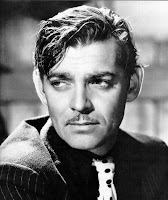

 Other forms of "moral turpitude" were concealed from the public.
Other forms of "moral turpitude" were concealed from the public. 

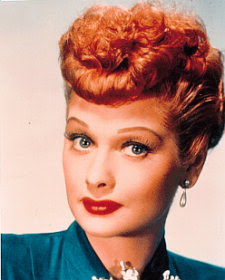

 And breasts?
And breasts? 


